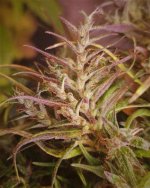For some years, people puzzled over why polytunnel plants were stronger than greenhouse grown. Eventually the right heads came together, and glasses greater ability to block UVB was realised to be behind the phenomena many had noticed from growing and smoking, but been unable to explain.
UV is simply damaging. The shorter the wave, the more damaging it gets. B might be 100 times more damaging than A, depending where in the A&B spectrum's you make the comparison.
UVA can be made with LEDs but UVB is a struggle. 0.02w might cost $50 and we want 1w a meter. $2500 per meter. UVA isn't so expensive, but B can be made fairly cheaply with fluorescent lamps, making the production of A using LEDs look equally as outrageous.
This leaves our UV production best done with flo's in the B band. Reptile bulbs can cover a meter for that $50 and $25 isn't unreasonable if you shop around.
Simply the act of causing damage triggers a protection response. This builds up a resilience within the plant though over time. So our first reaction is keep adding more UV. Recent tests have shown that pulsing the UV could trigger a good response without building up such a tolerance. Using a 7 day timer, our option would be 3 days a week. This was done with UVB over basil and saw 25% more flavour. A different crop, but not just different plants but also people seem to have a similarly adverse reaction, so it's not a huge leap, and one Bruce felt he should share.
The UVA LED's are in fittings because we keep asking for them. They're are just a waste of space that could of been occupied by a useful LED. Even for making fish look nice, UV LED lights are not really marketed. You find LED fittings with flo's hidden in the middle when you look.
One day we will have reasonable UVA LED's and will will know when the roboscan at the nightclub gets really funky.
UV is simply damaging. The shorter the wave, the more damaging it gets. B might be 100 times more damaging than A, depending where in the A&B spectrum's you make the comparison.
UVA can be made with LEDs but UVB is a struggle. 0.02w might cost $50 and we want 1w a meter. $2500 per meter. UVA isn't so expensive, but B can be made fairly cheaply with fluorescent lamps, making the production of A using LEDs look equally as outrageous.
This leaves our UV production best done with flo's in the B band. Reptile bulbs can cover a meter for that $50 and $25 isn't unreasonable if you shop around.
Simply the act of causing damage triggers a protection response. This builds up a resilience within the plant though over time. So our first reaction is keep adding more UV. Recent tests have shown that pulsing the UV could trigger a good response without building up such a tolerance. Using a 7 day timer, our option would be 3 days a week. This was done with UVB over basil and saw 25% more flavour. A different crop, but not just different plants but also people seem to have a similarly adverse reaction, so it's not a huge leap, and one Bruce felt he should share.
The UVA LED's are in fittings because we keep asking for them. They're are just a waste of space that could of been occupied by a useful LED. Even for making fish look nice, UV LED lights are not really marketed. You find LED fittings with flo's hidden in the middle when you look.
One day we will have reasonable UVA LED's and will will know when the roboscan at the nightclub gets really funky.




